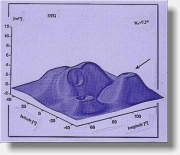The Truncation Filtering Methodology (TFM) belongs to the gravity data interpretation methods based on data enhancement and pattern recognition. The TFM is still under development. It is based on filtering the gravity data by means of integral transforms - convolution integrals - with various kernels and one free parameter. This leads to not one image but to an animated sequence of images displaying dynamic patterns. The patterns and their onsets are expected to serve for determining various geological formations and features and for estimating the depth of some of their elements. Such a knowledge and method of interpretation are to be achieved by means of synthetic modeling and case studies.
Gravimetric picture of the 2004 volcanic unrest on Teide, Tenerife, Canary islands
Gravity changes observed around Teide (Tenerife) between May 2004 and July 2005, due to the suspected reawakening of the volcano, were reinterpreted by us. Our objective was to seek multiple sources of the observed gravity signal. Our interpretation is based on the decomposition of the gravity signal into shallow and deep fields, and subsequent inversion of each field by means of 3D line segments. The shallow (near-surface) segments are interpreted as hydrothermal fluids. A short deep segment was found at the depth of about 6 km below sea level, interpreted as magma injection. Our results indicate that the 2004 volcanic unrest at the Central Volcanic Complex of Tenerife was a failed eruption.


